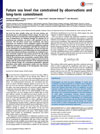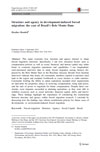-
1.3 Meters of Sea-Level Rise By 2100, and the Effects of Belo Monte’s Forced Displacement
March 9, 2016 By Haodan "Heather" Chen A study published by the Proceedings of the National Academy of Sciences projects future sea-level rise with a new model, providing crucial information for coastal planning and further impetus to cut carbon emissions. Sifting through data on thermal expansion and retreating glaciers, the two leading causes of sea-level rise in the past century, the authors confirm that sea level is rising at an unprecedented rate. In three scenarios based on future carbon emission levels, Matthias Mengel et al. project seas will rise between 57 centimeters and 1.3 meters by 2100 with no reduction of greenhouse gas emissions throughout the 21st century, and between 28 and 56 centimeters even if the emissions begin to decline in the next few years. They also predict that the Greenland and Antarctic ice sheets will likely become the main contributors of global sea-level rise when looking beyond this century. “If the world wants to avoid the greatest losses and damages, it now has to rapidly follow the path laid out by the UN climate summit in Paris,” said Anders Levermann, co-author of the study, in a press release.
A study published by the Proceedings of the National Academy of Sciences projects future sea-level rise with a new model, providing crucial information for coastal planning and further impetus to cut carbon emissions. Sifting through data on thermal expansion and retreating glaciers, the two leading causes of sea-level rise in the past century, the authors confirm that sea level is rising at an unprecedented rate. In three scenarios based on future carbon emission levels, Matthias Mengel et al. project seas will rise between 57 centimeters and 1.3 meters by 2100 with no reduction of greenhouse gas emissions throughout the 21st century, and between 28 and 56 centimeters even if the emissions begin to decline in the next few years. They also predict that the Greenland and Antarctic ice sheets will likely become the main contributors of global sea-level rise when looking beyond this century. “If the world wants to avoid the greatest losses and damages, it now has to rapidly follow the path laid out by the UN climate summit in Paris,” said Anders Levermann, co-author of the study, in a press release. Heather Randell takes a closer look at development-induced forced migration in a paper published by Population and Environment, focusing on the case of Brazil’s Belo Monte Dam. The hydroelectric project is expected to displace 20,000 people by the time it’s completed. Through pre- and post-displacement interviews, Randell examines the aspirations of migrants and compares them to end results. Despite many constraints, she finds most migrants succeeded in attaining aspirations and avoiding a decline in livelihoods thanks to strong social networks and human capital (health and income-generating skills). A recent history of migration among the communities affected provides people with direct or indirect migration experience, which also helped them adapt. “This is a promising finding,” she writes, because “even in a case that clearly falls toward the forced end of the migration continuum,” people can adjust if they have strong social networks and skills. Based on these findings, she suggests policymakers pay most attention to poorer, less skilled households with limited social networks when designing resettlement policies to avoid negative socio-economic effects.
Heather Randell takes a closer look at development-induced forced migration in a paper published by Population and Environment, focusing on the case of Brazil’s Belo Monte Dam. The hydroelectric project is expected to displace 20,000 people by the time it’s completed. Through pre- and post-displacement interviews, Randell examines the aspirations of migrants and compares them to end results. Despite many constraints, she finds most migrants succeeded in attaining aspirations and avoiding a decline in livelihoods thanks to strong social networks and human capital (health and income-generating skills). A recent history of migration among the communities affected provides people with direct or indirect migration experience, which also helped them adapt. “This is a promising finding,” she writes, because “even in a case that clearly falls toward the forced end of the migration continuum,” people can adjust if they have strong social networks and skills. Based on these findings, she suggests policymakers pay most attention to poorer, less skilled households with limited social networks when designing resettlement policies to avoid negative socio-economic effects.Source: Phys.org, Population and Environment, Proceedings of the National Academy of Sciences.
 A Publication of the Stimson Center.
A Publication of the Stimson Center.





